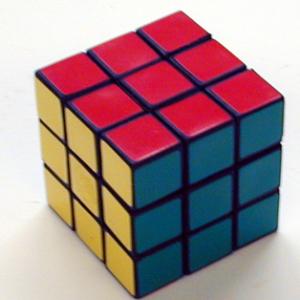College of Liberal Arts & Sciences
1A50.90 - Math Toys - Rubik's Cube
See also 7E10.50 in Modern.
The mathematics of solving the cube puzzle is described in the file. If however this does not suffice you can take the puzzle apart and reassemble it in the starting position by prying one of the corners up.
- D. Rae Carpenter, Jr., "Rubik's Cube Puzzle", TPT, Vol. 20, # 5, May 1982, p. 317.
- Solomon W. Golomb, "Rubik's Cube and a Model of Quark Confinement", AJP, Vol. 49, #11, Nov. 1981, p. 1030.
- Corinne Iozzio, "Gleaming The Cuboids", Popular Science, Spring 2018, p. 32 - 33.
- "Toy Origins", Uncle John's Bathroom Reader, p.169.
- Jearl Walker, "Now There Is a Rubik's Magic, a New Puzzle That Provides a Study in Permutation Operators", The Amateur Scientist, October, 1987.
- Ed Sobey, Woody Sobey, "Rubik's Cube", The Way Toys Work, p. 122 - 124.
- "Rubik's Cube", The New Illustrated Science and Invention Encyclopedia, p. 2281 - 2285.
- Editors of Portable Press, "Rubik's Cube Robot", Strange Science, p. 235.
- Mark Kennedy, "The Mind Behind the Rubik's Cube Celebrates a Lasting Puzzle", The Des Moines Register, December 4th, 2022.
- Todd Coopee, "Squaring Off with the Rubik's Cube", Reader's Digest, Sep. 2024, p. 26.
Disclaimer: These demonstrations are provided only for illustrative use by persons affiliated with The University of Iowa and only under the direction of a trained instructor or physicist. The University of Iowa is not responsible for demonstrations performed by those using their own equipment or who choose to use this reference material for their own purpose. The demonstrations included here are within the public domain and can be found in materials contained in libraries, bookstores, and through electronic sources. Performing all or any portion of any of these demonstrations, with or without revisions not depicted here entails inherent risks. These risks include, without limitation, bodily injury (and possibly death), including risks to health that may be temporary or permanent and that may exacerbate a pre-existing medical condition; and property loss or damage. Anyone performing any part of these demonstrations, even with revisions, knowingly and voluntarily assumes all risks associated with them.
